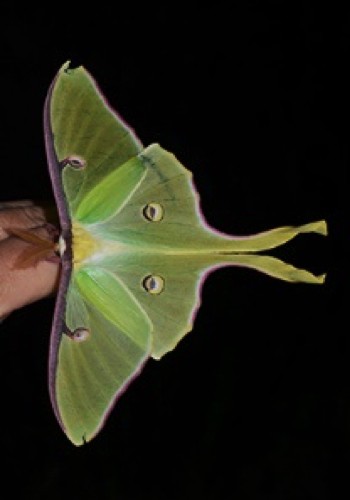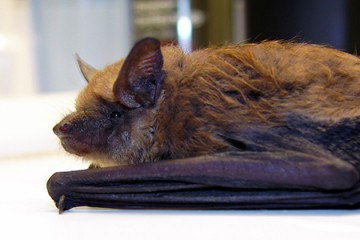It has long been suspected that the lengthy hindwing tails found on many moths are used to confound predators. The nocturnal insects don't need a visual disguise—they need to avoid nighttime hunters that navigate by sound.

Image caption: Luna moths have twisted tails that could confuse predators that hunt using echolocation
Image credit: Wu-Jung Lee/University of Washington
Researchers at Johns Hopkins University and the University of Washington took a detailed look at the common luna moth to see how long tails could create a sort of acoustic camouflage to throw off predators that use echolocation to guide their hunt. Results published in the Journal of the Acoustical Society of America suggest a strategy for how even a fairly small tail could confuse bats pursuing prey.
"The interesting thing about these tails is they are not just extensions—there is a twist toward the end," said first author Wu-Jung Lee, who conducted the research as a postdoctoral fellow at Johns Hopkins and is now a researcher at University of Washington's Applied Physics Laboratory. "We think that twist could be a key for how the tails function acoustically."
The study—co-authored by Cynthia F. Moss, a neuroscientist at Johns Hopkins—shows that without a tail, the center of the echo zeroes in on the moth. The twisted tail creates an echo from all directions that tends to shift the echo past the tip of the moth's body. About 53 percent of the time, the tail's reflection pushes the echo center beyond the tip of the moth's abdomen.
"If the bat always aims for the highest-amplitude echoes, there's a very small percentage of the time that the tail echoes would be dominant," Lee said. "But maybe by displacing the echo center, that can do the trick."
To understand how sound waves move around the moth while it is in flight, the researchers aimed short chirps with frequencies within the hearing range of bats at tethered, flying moths. The goal was to create a bat's "view" of the moth, although Lee cautioned it's not necessarily an exact match. The scientists then examined the returned echoes and compared them with video footage of the flying moth.
They were unsurprised to find that the tail does not provide a strong false target to replace the moth's body. Instead, they discovered that the echo created by the wings varies according to where in the moth's wingbeat a chirp strikes. If the wings are perpendicular to the incoming chirp sound waves, it creates a large echo, but if they are parallel, the wings offer a very small target. The moth's twisted tail, on the other hand, provides a consistent acoustic response regardless of the angle, which could create confusion around the varying main echo.
And if a bat was confused about the exact position of its prey, it might go for the center of several echoes. The twisted tail significantly throws off such an estimate, meaning the bat is more likely to miss.
"A moth is a very complicated object in space," Lee said. "It could be difficult for a bat to track each individual point of the echo cloud. It would be much easier for it to say, 'There's a ball of echoes coming back, I'm going to hit the center of it, and maybe I'll catch something.'"
Lee plans to learn more about how the tail influences moths' flight and study how different tail structures in other species of moths affect their survival rate against predatory bats.
Posted in Science+Technology
Tagged neuroscience









